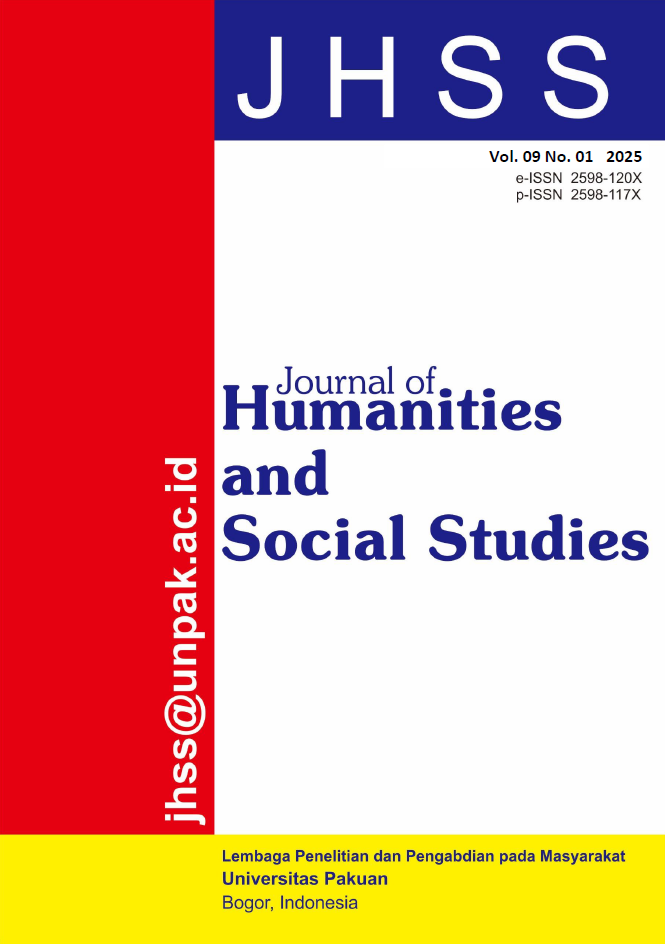The Role Of Collaborative Governance As An Effort To Activate Creative Centres: A Phenomenological Study In Purwakarta
DOI:
https://doi.org/10.33751/jhss.v9i1.54Keywords:
collaborative governance, creative economy, creative center, community participation, local policyAbstract
The implementation of collaborative governance in managing the creative economy sector has become increasingly essential, particularly at the local level where multiple stakeholders interact. This study explores the role of collaborative government in the activation process of the Creative Center Purwakarta (CCP), a collaborative space established to support creative community activities in Purwakarta, West Java. Employing a qualitative phenomenological approach, the research involved ten key informants, including government officials, CCP managers, members of creative communities, and residents directly engaged in the use of CCP. Data collection was conducted through in-depth interviews and document analysis. The findings reveal that although the government has provided facilities and regulatory support, collaboration remains limited to administrative coordination and has yet to fully foster participatory and innovative synergy. Personal engagement strategies, the government's facilitative role, and the ability to adapt to policy changes emerged as key factors driving effective collaboration. The study concludes that the successful activation of CCP requires a dialogic collaborative structure, facilitative leadership, and governance that is responsive to local policy dynamics. These findings offer practical implications for local governments in strengthening creative ecosystems and contribute to the theoretical development of collaborative governance in the creative economy sector.
References
A. F. Afrisal, “Collaborative Governance in Tourism Development Policy,” J. Soc. Sci., vol. 3, no. 6, pp. 1266–1270, 2022, doi: 10.46799/jss.v3i6.478.
E. Hysing, “Designing collaborative governance that is fit for purpose: theorising policy support and voluntary action for road safety in Sweden,” J. Public Policy, vol. 42, no. 2, pp. 201–223, 2020, doi: 10.1017/S0143814X2000029X.
E. Robert, S. Zongo, D. Rajan, and V. Ridde, “Contributing to collaborative health governance in Africa: a realist evaluation of the Universal Health Coverage Partnership,” BMC Health Serv. Res., vol. 22, no. 1, pp. 1–19, 2022, doi: 10.1186/s12913-022-08120-0.
T. Bjärstig, J. Johansson, I. Mancheva, and C. Sandström, “Collaboration as a policy instrument in public administration: Evidence from forest policy and governance,” Environ. Policy Gov., no. February, pp. 538–549, 2024, doi: 10.1002/eet.2099.
M. Musaad, “Implementation of Collaborative Governance in Public Policy Handling COVID-19,” Int. J. Sci. Soc., vol. 3, no. 4, pp. 227–235, 2021, doi: 10.54783/ijsoc.v3i4.476.
E. Sørensen and J. Torfing, “Accountable government through collaborative governance?,” Adm. Sci., vol. 11, no. 4, 2021, doi: 10.3390/admsci11040127.
M. Musleh, A. Subianto, M. H. Tamrin, and M. R. Bustami, “The Role of Institutional Design and Enabling Environmental: Collaborative Governance of a Pilgrimage Tourism, Indonesia,” J. Local Gov. Issues, vol. 6, no. 1, pp. 75–90, 2023, doi: 10.22219/logos.v6i1.22218.
E. L. Mészáros, “Collaborative governance for smart and sustainable cities of the 21st century. Case study: The city of Oradea,” Eur. Stud. Rev. Eur. Law, Econ. Polit., vol. 8, no. 1, pp. 205–221, 2021, doi: 10.2478/eustu-2022-0073.
A. Unceta, X. Barandiaran, and A. Lakidain, “Digitalisation of creative industries fostered by collaborative governance: public innovation labs in gipuzkoa,” Sustain., vol. 13, no. 5, pp. 1–20, 2021, doi: 10.3390/su13052568.
X. Li, J. S. Kim, and T. J. Lee, “Collaboration for community-based cultural sustainability in island tourism development: A case in korea,” Sustain., vol. 13, no. 13, pp. 1–17, 2021, doi: 10.3390/su13137306.
A. Nasir, Nurjana, K. Shah, R. A. Sirodj, and M. W. Afgani, “Pendekatan Fenomenologi Dalam Penelitian Kualitatif 1,” Innov. J. Soc. Sci. Res., vol. 3, no. 5, pp. 4445–4451, 2023.
Sugiyono, Metode Penelitian Pendidikan Pendekatan Kuantitatif, Kualitatif, dan R&D. Bandung: Alfabeta, 2012.
H. Heriyanto, “Thematic Analysis sebagai Metode Menganalisa Data untuk Penelitian Kualitatif,” Anuva, vol. 2, no. 3, p. 317, 2018, doi: 10.14710/anuva.2.3.317-324.
M. N. R. Handrawan and F. L. Nisa, “PERAN PEMERINTAH DALAM PENGGUNAAN EKONOMI KREATIF DENGAN KONDISI PERTUMBUHAN NILAI SDM DAN SDA YANG BERAGAM DI INDONESIA,” vol. 2, no. 3, pp. 157–169, 2024.
S. B. Merriam and E. J. Tisdell, Qualitative Research: A Guide to Design and Implementation. 2015.
R. Purbasari and R. Sukmadewi, “Digital Collaboration Network dalam Perspektif Digital Innovation: Studi pada Digital Entrepreneur,” JIIP - J. Ilm. Ilmu Pendidik., vol. 7, no. 6, pp. 5192–5204, 2024, doi: 10.54371/jiip.v7i6.4334.
A. Markusen and A. Gadwa, “Creative Placemaking: How to Do it Well,” Community Dev. Invest. Rev., vol. 2, no. October, 2014.
A. Malpass et al., “Create to Collaborate: using creative activity and participatory performance in online workshops to build collaborative research relationships,” Res. Involv. Engagem., vol. 9, no. 1, pp. 1–18, 2023, doi: 10.1186/s40900-023-00512-8.
M. Schöfer, N. Maranzana, A. Aoussat, G. Bersano, and S. Buisine, “Distinct and combined effects of disciplinary composition and methodological support on problem solving in groups,” Creat. Innov. Manag., vol. 27, no. 1, 2018, doi: https://doi.org/10.1111/caim.12258.
G. Evans, “Cultural planning and sustainable development,” in The Routledge Research Companion to Planning and Culture, Routledge, 2016, pp. 223–238.
M. Gasparin and M. Quinn, “Designing regional innovation systems in transitional economies: A creative ecosystem approach,” Growth Change, vol. 52, no. 2, pp. 621–640, 2021, doi: 10.1111/grow.12441.
M. Janssen and H. Voort, “No TitleAdaptive governance: Towards a stable, accountable and responsive government,” Gov. Inf. Q., vol. 33, no. 1, 2016, doi: https://doi.org/10.1016/j.giq.2016.02.003.
Q. Zhang, C. Ye, and J. Duan, “Multi-dimensional superposition: Rural collaborative governance in Liushe Village, Suzhou City,” J. Rural Stud., vol. 96, 2022, doi: https://doi.org/10.1016/j.jrurstud.2022.10.002.
Downloads
Published
How to Cite
Issue
Section
License
Copyright (c) 2025 JHSS (JOURNAL OF HUMANITIES AND SOCIAL STUDIES)

This work is licensed under a Creative Commons Attribution-NonCommercial-ShareAlike 4.0 International License.














